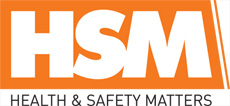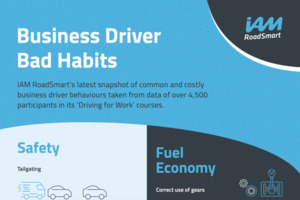
 |
Mark Sennett
Managing Editor |
 |
Kelly Rose
Editor |
| Home> | Managing Health & Safety | >Fleet & Driver Safety | >Bad driver habits are putting motorists at risk |
Bad driver habits are putting motorists at risk
21 October 2025
ALMOST A third of business drivers are not checking their mirrors or blind spots, potentially endangering themselves, other drivers and more vulnerable road users like cyclists according to our new research. Another fifth tailgate other drivers, a dangerous habit which can lead to rear-end collisions.

Data taken from more than 4,500 participants in the charity’s ‘Driving for Work’ training course revealed a series of potentially dangerous habits that are impacting both safety and fuel economy.
Some of the most concerning findings affecting safety included:
- Tailgating: 23 percent of business drivers do not maintain a safe following distance to vehicle ahead of them.
- Poor perception: 28 percent were failing to check their mirrors or blind spots; 22 percent were failing to observe the road ahead for potential hazards.
- Meanwhile, there were several behaviours observed that have the potential to impact fuel economy for fleets. These included:
- 33 percent of business drivers were rated as below average for gear selection appropriate to their speed.
- 34 percent were classed as poor for being able to manage speed and space around their vehicle.
- 19 percent of drivers routinely failed to change gear at the correct time, leading to unnecessary revving.
Commenting on the data, Nicholas Lyes, policy and standards director at IAM RoadSmart, said: “These findings will make disappointing reading for many fleet managers who are on the frontline for ensuring safety and reducing their organisation’s cost and carbon footprint.
“What these results show is that bad habits creep in over time, even with good drivers. The implications for fleets are significant, not only in terms of damage to vehicles, but for the safety of drivers and other road users and as a consequence, reputation. In far too many cases, drivers are failing to carry out even basic actions, like checking their mirrors or maintaining a safe distance from the vehicles in front.
“These actions also have cost implications – but a few small changes can make a big difference – such as eliminating over-revving and managing speed. By doing so, modestly sized fleets save tens of thousands of pounds each year, while larger fleets are potentially wasting more than £70,000 annually.
“Regular top-up driver training is the best way to maintain standards, keep safe on the roads and prevent the costs that come from poor driving behaviours from spiralling out of control.”
Its flagship ‘Driving for Work’ training course has been created specifically with business drivers in mind and is designed to equip them with the knowledge and skills that help them to stay safe on the road. For more information, please call us on 0870 120 2910 or visit our stand at HSM Live 2025, Glasgow.
If you’re joining us at the event don’t miss our Training Manager, Nick Saddington, presenting ‘When Good Intentions Go Wrong: Why Driver Training Needs Driver Trainer Expertise’. This talk will explain why expert input is essential and how well-intentioned training often backfires if it isn’t grounded in theory.
For more information, visit www.iamcommercial.co.uk
- Fleet management for a dispersed workforce
- Looking after your mental health post-lockdown
- New highway code now available in print
- Tips and posters about overloading vehicles
- New online course for people who manage driver risk
- New road laws in 2023
- Taking action on driver fatigue
- Accelerate road safety
- Safety culture: It’s all about attitude
- FREE Webinar - managing work-related driver risk
























